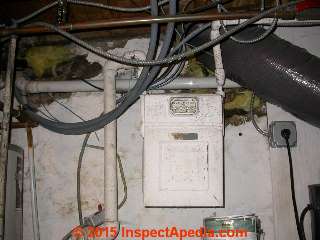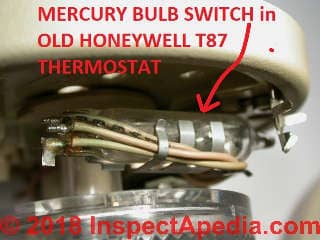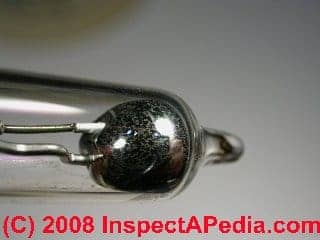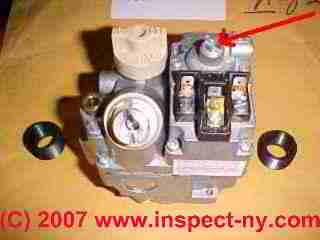 Mercury Hazards in Appliances & in Natural Gas Regulators
Mercury Hazards in Appliances & in Natural Gas Regulators
Where is mercury found in gas regulators & in household appliances & pump controls
- POST a QUESTION or COMMENT about inspecting, testing, diagnosing, and repairing gas piping, gas regulators, and gas storage tank defects used with LP or natural gas burning appliances
Mercury hazards in gas regulators, home appliances, switches, and controls.
Here we describe the most-common places that mercury may be found in regulators, switches, controls and appliances found in the home as well as in many other buildings.
Really? Well yes but: People can be exposed to harmful levels of mercury through inhalation or skin contact, but the primary route of exposure for most people today is eating mercury-contaminated fish. - CA EPA (2005)
InspectAPedia tolerates no conflicts of interest. We have no relationship with advertisers, products, or services discussed at this website.
- Daniel Friedman, Publisher/Editor/Author - See WHO ARE WE?
Mercury Hazards in Appliances & in Natural Gas Regulators
 Mercury was widely used as a reliable position control switch, most-often as a small quanity of mercury inside of a glass tube that rolled on or off of electrical contacts as the position of the tube was tippped.
Mercury was widely used as a reliable position control switch, most-often as a small quanity of mercury inside of a glass tube that rolled on or off of electrical contacts as the position of the tube was tippped.
Probably the most-widel-installed mercury switch was in Honeywell's traditional T87 wall thermostat used to control heating and air conditioning equipment and manufactured as early as 1953.
How to check your thermostat for mercury:
Simply pull the cover off of your thermostat and look for the glass bulb containing a drop of mercury - upper left in our photo.
Modern Honeywell and other room thermostats don't contain mercury and have not for some time. Instead these newer temperature sensing devices may use a thermistor.
Watch out: Mercury is a neurotoxin and even
short-term exposure to high levels of
metallic mercury vapors may cause
effects including lung damage, nausea, vomiting, diarrhea, increases
in blood pressure or heart rate, skin
rashes, and eye irritation.
Long
term exposure can cause damage to
the brain, kidneys, liver and heart.
When a mercury-containing product breaks and the mercury is spilled,
the exposed mercury can evaporate
and become an invisible, odorless
toxic vapor. Some of these products
such as mercury-containing thermometers can break easily and spill
mercury.
To prevent mercury releases, these products should be used
and stored safely by maintenance
personnel and service technicians. - U.S. HUD (2008) and Main DEP (2004)
Where was Mercury Commonly Used in Home Devices?
Mercury switches were used in a range of electrical appliances such as chest freezers, sump pumps (and bilge pumps), washing machines and water heaters. sile
Mercury may also appear in electrical switches such as silent wall toggle switches, garage door openers, electric irons, clothes dryer lids, washing machine lids and sensors, and other sources listed herein.
Thermocouples, in particular steel or stainless-steel (not copper) used on older gas appliances may also contain mercury, and finally (well semi-finally), mercury was also used as a component in some natural gas regulators.
Mercury may also be in your car, in a hood light switch or trunk light switch sensor.
Details about where mercury was used in these controls and switches and how to remove or dispose of mercury switches, regulators and other controls safely are given in this article.
Mercury Hazards in Home Appliances, Thermostats, Controls, Reglators & Other Sources
 Our photo shows what a mercury bulb looks like in a traditional room thermostat, viewed from above with the thermostat cover removed.
Our photo shows what a mercury bulb looks like in a traditional room thermostat, viewed from above with the thermostat cover removed.
Photo below: a large drop of mercury is shown in the end of a glass bulb the mercury bulb switch used in older Honeywell T87 room thermostats.
In this position the metallic droplet of mercury makes an electrical connection between two metal probes forming the actual position-sensitive switch.
Really? mercury inside of the glass bulb is not a direct health or environmental hazard. Don't panic about an old mercury-bulb thermostat or control, but do handle its disposal properly.
The mercury hazard would arise if the (rather tough) glass bulb is shattered, releasing mercury.
That can happen during scrap metal operations when an older appliance containing a mercury switch is re-cycled.
Most communities have regulations about the disposal of mercury switches and controls and provide disposal advice. You'll find examples in our citations below.
Research on the question of whether or not mercury was also used in gas appliances, where it appears and how to handle mercury-containing switches and controls is given below.
Household & Building Small Mercury Hazard Sources, Research, Cleanup Instructions
 All appliances manufactured after March 1, 2000 should be labeled if they incorporate a mercury-containing device.
All appliances manufactured after March 1, 2000 should be labeled if they incorporate a mercury-containing device.
- CA DTSC, HOW TO HANDLE MERCURY
SWITCHES IN MAJOR APPLIANCES [PDF] (2005) California Departmentof Toxic Substances Control, 1001 I Street
Sacramento, CA 95814-2828
Mailing Address:
P.O. Box 806
Sacramento, CA 95812-0806 USA retrieved 2019/02/16 original source: https://www.dtsc.ca.gov/HazardousWaste/Mercury/upload/HWMP_FS_Merc-Appliances.pdf
This fact sheet explains how to remove and handle mercury switches before you crush or shred a major appliance. - CA EPA, SELF – TRAINING MANUAL FOR REMOVING MERCURY SWITCHES FROM MAJOR APPLIANCES [PDF] (2004) A Guide for Appliance Recyclers, California Environmental Protection Agency, retrieved 2019/02/16 original source: http://www.bvsde.paho.org/bvsacd/cd25/self-mercury.pdf
- Hryhorczuk, Daniel, Victoria Persky, Julie Piorkowski, Jennifer Davis, C. Michael Moomey, Anne Krantz, Ken D. Runkle, Tiffanie Saxer, Thomas Baughman, and Ken McCann, RESIDENTIAL MERCURY SPILLS FROM GAS REGULATORS [PDF] retrieved 2019/02/16 original source: www.ncbi.nlm.nih.gov/pmc/articles/PMC1480493/
- Maine DEP, HOUSEHOLD APPLIANCE MERCURY SWITCH REMOVAL MANUAL [PDF] (2004) Maine Department of Environmental Protection 17 State House Station Augusta, Maine 04333-0017 Attention: Mercury Products Program Division of Solid Waste Management Telephone: (207) 287-2651 retrieved 2019/02/16, original source: https://www.nrra.net/wp-content/uploads/Mercury-Switch-Removal-Manual-State-of-ME.pdf
- NAU, MERCURY IN THE HOME [PDF] Northern Arizona University, retrieved 2019/02/16, original source: http://www7.nau.edu/itep/main/hazsubmap/docs/Mercury/MercuryInHome.pdf
This article adds these common mercury sources in the home: antiseptics, batteries, barometers, paints, old chemistry sets, thermometers, lighted athletic shoes, pesticides, irons (clothing) that contain a tilt- or tip- detection swtich, microwave ovens. - NEWMOA, INSTRUCTIONS FOR CLEANING UP “SMALL” LIQUID MERCURY SPILLS
IN HOUSEHOLDS [PDF] (2003) NEWMOA, 89 South Street, Suite 600, Boston,antis MA 02111 USA, Northeast Waste Management Officials Association, retrieved 2019/02/16, original source: http://www.newmoa.org/prevention/mercury/smallspills.pdfmicrow
as cited and linked-to in the US HUD article listed later in this reference list.
Excerpt: With input from the state environmental agencies of Connecticut, Maine, Massachusetts, New Hampshire, New Jersey, New York, Rhode Island, and Vermont, the Northeast Waste Management Officials’ Association (NEWMOA) combined available spill clean-up instructions with the experience of individuals who have cleaned up mercury spills to create this document.
It contains basic clean-up instructions for small liquid mercury spill. - RI DEM, MERCURY in COMMON HOUSEHOLD PRODUCTS [PDF] Rhode Island Department of Environmental Management, 235 Promenade St.
Providence, RI 02908-5767 USA,
Excerpt:
Other sources of mercury in homes:
Weight/counterweight in grandfather clocks
Jewelry with a glass ampoule containing mercury
Elemental mercury saved from an industrial application, laboratory or prior activity
Many button batteries in particular from older hearing aids
Lights in some older model children’s tennis shoes
Old batteries of any type (pre-1990)
Irons with tilt safety switches
Automotive trunk, and hood light switches, high intensity headlights and ABS braking systems
Some, gas flow meters, bilge and sump pumps, and older silent light switches
For questions about the use of mercury in residential homes and the potential issues related to such use, please contact DEM at (401) 222-2797, extension 7140 or the Department of Health at (401) 222-3424.
- U.S. EPA, MERCURY HAZARD in OLD GAS REGULATORS [PDF] "Before You Tear it Down, Get the Mercury Out Recommended Management Practices for Pre-Demolition Removal of Mercury-Containing Devices from Residential Buildings" U.S. Environmental Protection Agency, retrieved 2019/02/16 original source: www.epa.gov/sites/production/files/2015-10/documents/before_you_tear_it_down.pdf
- U.S. HUD, "Help Housing Authority Maintenance Staff Reduce the Risk of Mercury Spills" [PDF] retrieved 2019/02/16, original source: https://www.hud.gov/sites/documents/DOC_10647.PDF
- VT DEC, HOUSEHOLD APPLIANCE MERCURY SWITCH REMOVAL MANUAL [PDF] (2002) Vermont Department of Environmental Conservation et als, Vermont Agency of Natural Resources
Environmental Assistance Division
103 South Main Street, Laundry Building
Waterbury, VT 05671-0411
Attention: Thomas A. Benoit
Telephone: 802-241-3472
tombe@dec.anr.state.vt.us
retrieved 2019/02/16 original source: https://www.nrra.net/wp-content/uploads/Mercury-Switch-Removal-Manual-State-of-VT.pdf
This document lists additional common household sources of mercury including: mercury found in [Italics are excerpts from the document above]
Excerpts: One of Vermont’s other efforts is the removal of mercury from discarded household appliances or “white goods”.
Many of these white goods, which are currently being collected for their scrap metal value, contain mercury switches and thermocouples.
Mercury was used in household appliances due to it being a highly reliable means for electrical switching in varied temperature and moisture conditions.
Mercury Controls in Chest Freezers - Some chest freezers are made with a mercury switch inside the freezer cover light socket
Mercury Controls in Washing Machines - Mercury switches were used in a small number of washing machines manufactured prior to 1972 ... mercury switch was used to detect a lid opening and engage a brake ... this switch is located between the washer tub and the cover for the tub area of the washer
and mercury switches in washing machines was in the dynamic stabilizing system to prevent a severe out-of-balance condition (only on certain models).
Mercury Controls in Gas Ranges - in the form of ... a mechanical safety device to detect whether the pilot-light is on and shut off the supply of
gas to the burner when the pilot-light is not burning ... beneath the oven cavity in the broiler pan. ...
Many ... stainless steel safety valve capillary tubes and sensor bulbs are mercury-containing devices while copper safety valve capillary tubes and sensor bulbs are nonmercury containing devices.
As a general rule, magnetic metals are mercury-containing probes while non-magnetic metals are non-mercury containing probes. ... Temperature capillary tubes and bulbs found within ovens or below upper burners are usually copper probes.
A copper probe is good indication of a non-mercury containing device. ... Use a magnet to determine if it is indeed a mercury probe (non-magnetic probes are non-mercury).
Mercury Controls in Gas Hot-water Heaters - Although all the current literature states that mercury was not used in residential hot-water heaters, the following procedure has been included to help prevent any mercury-added thermocouples from entering the waste stream and eventually the environment.
Use a magnet to determine if it is indeed a mercury probe (non-magnetic probes are non-mercury). .
...Magnetic probes were usually found on commercial hot-water heaters of 100 gallons or more
Mercury Controls in Sump and Bilge Pumps - as a float switch in sump and bilge pumps
Question: do old gas appliance pressure regulators contain mercury?
 2019/02/16 Michael Soules said:
2019/02/16 Michael Soules said:
Do older gas pressure regulators leading to an individual gas appliance (gas fireplace, range, etc.) ever contain mercury?
I know that older gas regulators leading into a home sometimes contain mercury, and would like to know if the pressure regulators for a single appliance can as well. (The specific situation I'm interested in involves a gas fireplace connected to a very old-looking pressure regulator.)
Here are the articles I've seen that discuss mercury pressure regulators:
- Hryhorczuk, Daniel, Victoria Persky, Julie Piorkowski, Jennifer Davis, C. Michael Moomey, Anne Krantz, Ken D. Runkle, Tiffanie Saxer, Thomas Baughman, and Ken McCann, RESIDENTIAL MERCURY SPILLS FROM GAS REGULATORS [PDF] retrieved 2019/02/16 original source: www.ncbi.nlm.nih.gov/pmc/articles/PMC1480493/
- U.S. EPA, MERCURY HAZARD in OLD GAS REGULATORS [PDF] "Before You Tear it Down, Get the Mercury Out
Recommended Management Practices for Pre-Demolition Removal
of Mercury-Containing Devices from Residential Buildings" U.S. Environmental Protection Agency, retrieved 2019/02/16 original source: www.epa.gov/sites/production/files/2015-10/documents/before_you_tear_it_down.pdf
This mercury hazard Q&A were posted originally
at GAS LP & NATURAL GAS SAFETY HAZARDS
Reply: yes, some: reports of in-home mercury spill hazards during removal of old gas regulators
What a great question, Michael. Thank you. Mercury in gas appliance regulators isn't something I'd considered.
Hryhorczuk (2006) certainly makes the point, in the NCBI citation you offered, but specifically that paper focuses on gas regulators at the building point of supply, not appliance regulators.
Many older homes are equipped with mercury-containing gas regulators that reduce the pressure of natural gas in the mains to the low pressure used in home gas piping.
Removal of these regulators can result in elemental mercury spills inside the home. In the summer of 2000, mercury spills were discovered in the basements of several Chicago-area homes after removal of gas regulators by gas company contractors.
Subsequent inspections of approximately 361,000 homes by two northern Illinois gas companies showed that 1,363 homes had residential mercury contamination.
Urine mercury screening was offered to concerned residents, and results of urine bioassays and indoor mercury air measurements were available for 171 homes. Six of these 171 homes (3.5%) had a cumulative total of nine residents with a urine mercury ≥ 10 μg/L.
The highest urine mercury concentration observed in a resident was 26 μg/L.
Positive bioassays were most strongly associated with mercury air concentrations > 10 μg/m3 on the first floor [odds ratio (OR) = 21.4; 95% confidence interval (CI), 3.6–125.9] rather than in the basement (OR = 3.0; 95% CI, 0.3–26), and first-floor air samples were more predictive of positive bioassays than were basement samples.
Overall, the risk of residential mercury contamination after gas regulator removal ranged from 0.9/1,000 to 4.3/1,000 homes, depending on the gas company, although the risk was considerably higher (20 of 120 homes, 16.7%) for one of the contractors performing removal work for one of the gas companies.
Gas companies, their contractors, and residents should be aware of these risks and should take appropriate actions to prevent these spills from occurring and remediate them if they occur.
Your EPA citation (thanks again) states
Issue: Some homes that were built prior to 1968 have a mercurycontaining gas pressure regulator adjacent to the gas meter.
Most of these devices were manufactured and installed in the 1940s and 1950s, but a few were manufactured and installed in some areas as late as 1967. These devices contain approximately two teaspoons of mercury.
Mercury spills have sometimes occurred during improper removal of these devices, causing a potentially significant health risk and resulting in costly cleanups.
Recommended Management: Mercury-containing gas pressure regulators should be removed only by qualified gas company personnel.
Frankly I was surprised that anybody was seriously worried about a mercury spill from removing an old gas service regulator as normally those devices would be removed intact. I suppose if one were internally damaged a mercury spill might still ensue.
Again neither of those articles points to gas appliance regulators.
Watch out: another common source of mercury in heating equipments are older mercury-bulb type room thermostats like the old Honeywell T87 thermostat scited earlier.
...
Continue reading at ENVIRONMENTAL HAZARDS - INSPECT, TEST, REMEDY - topic home, or select a topic from the closely-related articles below, or see the complete ARTICLE INDEX.
Or see these
Mercury, Appliance & Device Control Articles
- APPLIANCE DIAGNOSIS & REPAIR - home
- GAS REGULATORS & APPLIANCE / HEATER CONTROLS
- THERMISTORS in ROOM THERMOSTATS
- THERMOCOUPLE REPAIR / REPLACEMENT
- THERMOSTAT INSTALLATION STEPS - how to replace or install a new thermostat
Suggested citation for this web page
MERCURY HAZARDS in APPLIANCES & GAS REGULATORS at InspectApedia.com - online encyclopedia of building & environmental inspection, testing, diagnosis, repair, & problem prevention advice.
Or see this
INDEX to RELATED ARTICLES: ARTICLE INDEX to GAS APPLIANCES, PIPING, CONTROLS
Or use the SEARCH BOX found below to Ask a Question or Search InspectApedia
Ask a Question or Search InspectApedia
Questions & answers or comments about inspecting, testing, diagnosing, and repairing gas piping, gas regulators, and gas storage tank defects used with LP or natural gas burning appliances
Try the search box just below, or if you prefer, post a question or comment in the Comments box below and we will respond promptly.
Search the InspectApedia website
Note: appearance of your Comment below may be delayed: if your comment contains an image, photograph, web link, or text that looks to the software as if it might be a web link, your posting will appear after it has been approved by a moderator. Apologies for the delay.
Only one image can be added per comment but you can post as many comments, and therefore images, as you like.
You will not receive a notification when a response to your question has been posted.
Please bookmark this page to make it easy for you to check back for our response.
IF above you see "Comment Form is loading comments..." then COMMENT BOX - countable.ca / bawkbox.com IS NOT WORKING.
In any case you are welcome to send an email directly to us at InspectApedia.com at editor@inspectApedia.com
We'll reply to you directly. Please help us help you by noting, in your email, the URL of the InspectApedia page where you wanted to comment.
Citations & References
In addition to any citations in the article above, a full list is available on request.
- In addition to citations & references found in this article, see the research citations given at the end of the related articles found at our suggested
CONTINUE READING or RECOMMENDED ARTICLES.
- Carson, Dunlop & Associates Ltd., 120 Carlton Street Suite 407, Toronto ON M5A 4K2. Tel: (416) 964-9415 1-800-268-7070 Email: info@carsondunlop.com. Alan Carson is a past president of ASHI, the American Society of Home Inspectors.
Thanks to Alan Carson and Bob Dunlop, for permission for InspectAPedia to use text excerpts from The HOME REFERENCE BOOK - the Encyclopedia of Homes and to use illustrations from The ILLUSTRATED HOME .
Carson Dunlop Associates provides extensive home inspection education and report writing material. In gratitude we provide links to tsome Carson Dunlop Associates products and services.

